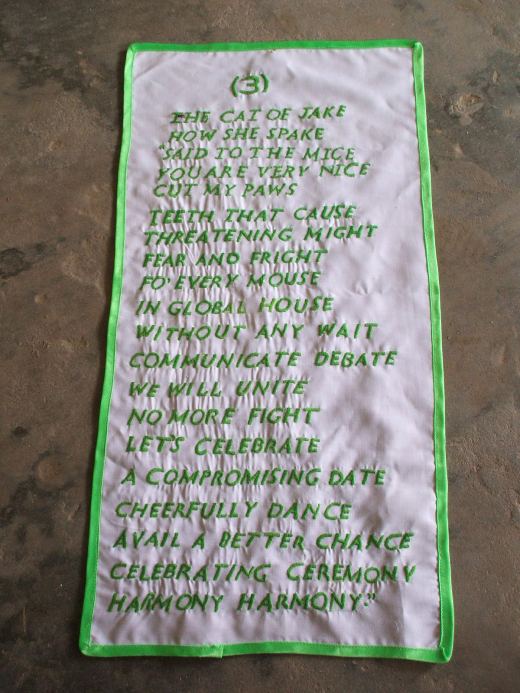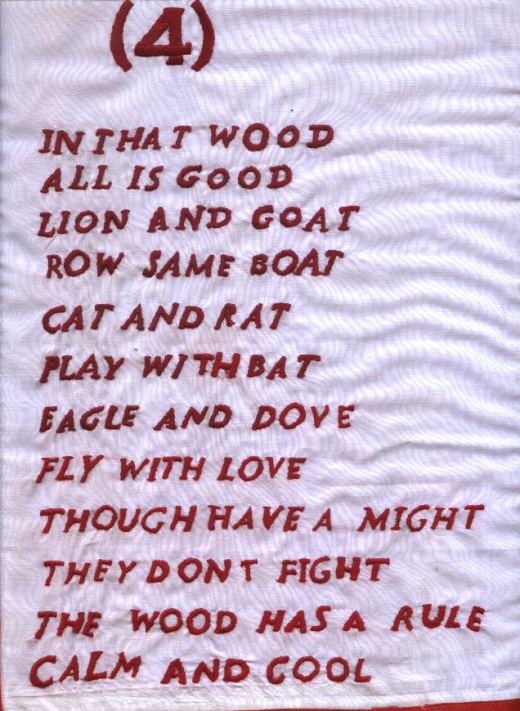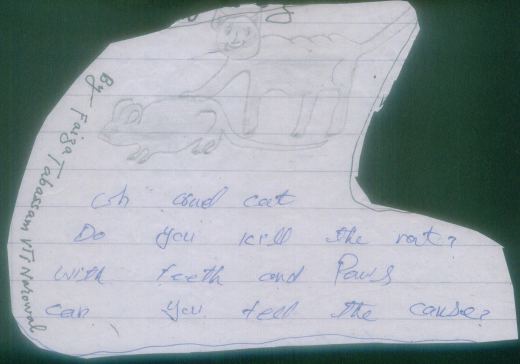Celebrating International Day of Peace in the Class
Muhammad Iqbal, Pakistan
Muhammad Iqbal grew up in a small village of Punjab. He has been writing poetry since his school days in different languages. He started writing for peace and other global issues particularly after earthquake in South Asia and in his own country to aware new generations. His children poems and songs have been published in different international teaching newsletters. He is writing two books of children poems and songs very suitable for teaching in the classroom- one for global issues and the other deals with everyday English themes. He teaches English in a vocational institute working for poverty alleviation and rehabilitation of the poor in Narowal, Pakistan. He is the member of a number of national and international associations and Membership Officer for Global Issues SIG.
http://gisig.iatefl.org/pages/contact.html
E-mail: muhammadiqbal722@hotmail.com
Menu
Introduction
Preparation
Why poems in class?
Presenting poems in the class
Speaking
Grammar
Listening
Collaborative writing
References
The article includes the week long-activities we celebrated at our institute immediately after the international Day of Peace believing that we are what we celebrate. The work focuses on teaching peace poems (written by the author) for language learning and global awareness.
The four peace poems were embroidered by my female students of Dress Making Trade in an NGO, Swaira Ladies Club a working partner of our institute before the International Day of Peace but I taught the poems to my female students of Computer Operator/Assistant Trade at Vocational Training Institute. The copies of embroidered poems were cut into pieces and put in 6 envelopes. A few days before teaching the poems, a general lecture on peace was delivered to all of the students of my institute in assembly with reference to the Magna Charta of Harmony (Leo Semashko et al-World Harmony Academy Project 08). How most of the scholars and nations had been involved in struggles and how the ideas are coming towards Global Peace and Harmony? Though world is facing the crucial challenges of war and terrorism, there are still a number of people who are working consistently for global peace and harmony.
1. Poetry in our life
I frequently put pen to paper for chants, rhymes, poems and songs for classroom practice because most of the professionals advocate and validate as they smooth the progress of both the teacher and the leaner. “Poetry helps us understand ourselves and our world. It helps us see ourselves and our world in new ways. The same time, poetry lifts our language. We find ourselves using language in new ways, in ways that are more vivid, more powerful and more fun. Poetry makes it clear that literacy is not just a set of mechanical skills for reading job advertisements or filling our applications” (Francis E.Kazemek and Pat Rigg, 1995).
2. Poet before the learners
When I share or present my poetry in the class with pedagogical activities my students feel pleasure and they are always delighted to find me a poet before them: “children need poetry………they need the opportunity to share dreams and feelings. They need to hear the poets speaking to them and to realize that poets are people just like them” (Tiedt 2002).
3. Potential in rhythm
Over the years I dig up that rhythm had potential to take the lingo beyond our classes. Last year, I created a small poem. I shared it with only one of my classes. Next day, I entered into another class and found my students singing this poem with pleasure and joy. Some students were heard to be singing the same poem in the streets. Presumably, rhythm takes language beyond the specific locale. Observation shows that students usually share poems and songs with their families and friends especially if they are written by their teachers. Learners get inspiration and carry the ideas of poems and songs to their families and friends with amusement and keen interest.
4. Pakistani society and songs
Pakistan has a society very fond of hearing songs. Contrary to Western communities Pakistanis cannot move without hearing some songs in transport during travel. As I am the teacher of an international language, I write poems and songs on global issues to influence the learners. “The popularity of songs in oracy- based societies of India and Pakistan make them (songs and poems) a potent source of influencing masses” (Dr. Shahid Saddiqui 08).
5. My local style in poetry
I generally write chants, rhymes, poems and songs on global issues. I propel the style and rhythm of L1 in my artifacts and blurbs because I believe that non Eurocentric English styles and teaching methodologies work even better in the class “as it is an international language, the use of English is no longer connected to the culture of inner circle countries” (Sandra Lee McKay 2002). Why don’t we create our own material to teach within our own context and face our own challengeable circumstances “teaching with nothing?” (Adrian Tennant 07).
6. Creativity in EFL classes
Creativity constantly brings something new in every field. Art and Literature has also no exemption. For example Haiku is a Japanese origin poem and some writers are over authoritarian to follow its stereotypes. They believe that Haiku must tag along a three line 5-7-5 syllable format but on the other hand some connoisseurs say, “We strongly recommend not writing Haiku in this fashion. A focus on the number of syllables often results in undue attention to the form rather than to the creation of an interesting poem. Moreover, this focus on syllables is often frustrating to people who are not proficient readers and writers” (Francis E. Kaszemek and Pat Rigg 1995). Consequently, we can write poetry as “it helps us understand ourselves and our world” and as our students get pleasure from it in the class or as they prefer it to be created. As a result, we should acclimatize the style, form and rhythm our students like. It can enhance the learning process as Carolyn Graham maintains, “Using rhythm to introduce new vocabulary offers our students a very fast track for learning” (Carolyn Graham 2006).
1. Cutting the poems into pieces
I made 6 sets of poems and cut them into pieces. The pieces were enveloped and divided in 6 groups of the class. The students were asked to re-arrange the poems and share with other groups.
Acknowledgement:
I got this idea from an American website: www.poeticpower.com
2. Displaying poems
I displayed my embroidered peace poems on the classroom notice board and ask my students to match up their poems to the ones they had arranged. All groups corrected the poems and their sequence.




I send my sincere thanks to Ms Shagufta Shafiuque Instructor Dress Making Trade at Swaira Ladies Club and our trainees --- Ayesha Orooj, Saima Ramzan, Masooma Tahir, Shamaila Ramzan,Tanzila Rani, Sonia Tahir and Iqra Tahir who arranged the poems to be embroidered for presenting in the class and at SPELT international conference 08.
3 Reading aloud the poems
I read aloud the verse to the learners with rhythm because “Poetry is especially well suited to reading aloud; it is meant to be heard. Through reading poetry aloud to your students you are:
- Stimulating thinking
- Motivating students to read independently
- Providing amusement and entertainment
- Sharing feelings
- Providing support for slower students
- Sharing your enthusiasm for poetry
- Developing students language abilities
- Teaching listening skills
- Developing support with your students and creating a sense of community.” (Tiedt 2002)
I turned towards rhyme and rhythm. I felt that rhyme and rhythm was not suitable for my learners because they were all teeny, not children. Contrary to my expectations, I found all them enjoying and interested. “The rhythmical attraction of chanting is common to all humans, young or old.” (Carolyn Graham 2006)
I asked to the learners to read aloud poems in groups with rhythm. Next I asked the students to make some rhyming stairs on their notebooks and speak rhyming words imagining that they are stepping up on the stairs. The learners enjoy this activity very much. McClure (1995) rightly says, “Rhyme, in particular, is usually one of the first things children notice about poetry”. My experiences and observations show that foreign learners do not enjoy poetry devoid of rhyme and rhythm.
4. Illustrating poems

The learners were asked to write all of poems on their notebooks trimly and beautifully and illustrate some of them on blank papers in groups. My students are not proficient in drawing. Consequently most of them could not do this activity satisfactorily.
5. Comprehension questions
I presented some comprehension questions. I would like to share only a few of them:
- What do you like about the poems?
- Does this remind you any thing happened with you?
- How the rhythm makes you feel? Is this something like in our own language?
- Is there anything like your life?
1. To address the issues
I could not satisfy just to raise the above-cited conventional and traditional questions. I wanted to hear the voices of my students from their hearts. I knew that my poems would divide my students in so far as their personal beliefs and values were concerned. I thought I had to aware and prepare my students for the global village for “we believe that teachers must prepare our students for the global village and the diverse groups of people they will be living and working with during their life times. Our young people need to learn about differing values, ones that we question, ones that divide us and ones that unite us”
(Patricia Ruggiano and Ann Walts Pailliotet, 2001).
2. Voices in the class
Generally when we teachers want our students to verbalize their opinions and views, they ‘freeze’ and become unenthusiastic. In such kind of challenges, we should look up and use some classroom material that must have potential to stimulate discussion on the basis of ‘gap.’ “One of the richest sources of discussion activities in recent EFL methodology has been exploitation of the ‘gap’ whether information gap, opinion gap or values gap, questionnaires, ranking activities and values clarification tasks are all designed to highlight differences between people and thus to stimulate discussion and debate” (Jill Hadfield 1992). For all these aforementioned purposes, I picked out my first poem from all four ones ------- tiny but the most debatable one. I put in writing it on the whiteboard with marker, the only material we usually use in our institute:
Oh, cruel cat
Do you kill the rat?
With teeth and paws
Can you tell the cause?
The poem, allegorically, itself is a serious question to nations involved in war and terrorism. I asked my students to group themselves into fives on the basis of friendship, and cooperation to address the question in the poem because “a group is more likely to be cohesive and work productively if its members know something about each other and are willing to disclose information about themselves” (Jill Hadfield 1992).
3. ‘Think Time’
I asked my students to take some time for thinking freely because “it is an indispensable tool for teaching reflective learning which promotes students autonomy and plays a major roles in ‘learning to learn’ (Ricardo Sampedro and Susan Hillyard 2004).
4. Prompts
I wrote some prompts on the board:
Cat is brutal-minded by nature.
Cat is hungry
Cat is uneducated
Cat has threatening might
Cat does not believe in dialogue, and the like.
I tried to elicit the opinions and views. Most of my students were of the view that cat was un-educated. It did not have awareness how to bring a halt to killing with dialogue and reciprocal talk.
My students are girls and boys of poor families living in the rural vicinities. They do not have so much practice of speaking English. However they have made progress by leaps and bounds. Some of them were not speaking so far and remained reticent. I wrote some more prompts on the board so that shy students could also speak and comment:
I notice…………………
I can’t believe ………………
This made me think of ………………..
Sometime I am not sure about……………
It seamed real life when the cat………………………..
I wonder what will happen if cat ………………………
I like the way the poet …………………….
The way I think the cat looks is ………………….
If I were writing the poem I …………………….
I hope that …………………………………
This reminds me something in my own life………………
I think prompts are very functional where the learners hesitate and freeze. Prompts inspire them to warm up, join in debate and become bold enough to speak.
5. Role Play
I paired up the class and asked them to write a dialogue between cat and mouse while re-reading all the poems. Some of my students performed poems with role play of cat and mouse.
1. Grammar problems
English grammar is the most daunting theme for pastoral teachers and learners. In truth, many students leave their education because they think they can’t face the challenges of English grammar. We teachers of Pakistan are always wrestlers of grammar errors:
“Each year when students are inducted in professional universities especially after completion of higher secondary schooling, they have to undergo courses of English that are meant to give them proficiency in technical education. Unfortunately, majority of the students are still struggling with tenses and find it difficult to put together even a short coherent piece of writing” (Dr. Hina Ashraf et al 08). To face this challenge, I have developed my own philosophy of teaching language.
2. My philosophy of teaching English
“If I exist, I do move and if I move I do change or be changed that
is equivalent of global harmony.”
The first part of the statement is about Existence and Movement whereas the second one deals with sociolinguistics for global harmony and peace. I have divided language into two parts _____ existence and movement. Language is the expression of ‘when how where what the things are and how they move. Communication is just a tool to link this expression between social classes and nations. The Expression and Communication are two different things. I have had classroom experiments on this philosophy of teaching I have found it to be very successful particularly teaching English for slow learners in backward areas. Many other experts have identified these two areas of the language but not philosophically:
(i) “We use there is or there are etc to say that something or somebody exist” (Michael Swan and Catherine Walter 2001)
(ii) Broadly speaking, nouns and adjectives can be characterized naturally as ‘stative’ …............... on the other hand, verbs and adverbs can be equally naturally characterized as ‘dynamic’……………. These relations between the open classes can be summarized thus:
| Stative |
Noun |
Adjective |
| Dynamic |
Verb |
Adverb (Randolph et al 06) |
3. Practical
I had already taught English language to my learners according to this theory and on the basis of their previous knowledge I asked them to identify ‘Existo Sentences’ and Movo- Sentences in the poems. They did so successfully and made passive voice of the Movo-Sentences, for instance:
| Active Voice |
Do you kill the rat? |
| Passive Voice |
Is the rat killed by you (the cat)? |
4. Grammar definitions
I have also changed the conventional definitions of grammar. I asked the learners to do some work on poems according to the definitions. Needless to say, they did so successfully.
5. Pronouns
I wrote the Pronouns and a Dialogue on the whiteboard:
| PROUNONS |
DIALOGUE |
| I |
my |
me |
|
A: Where is she? |
| We |
our |
us |
|
B: She’s in the bus. |
| You |
your |
you |
|
A: What‘s she to do? |
| He |
his |
him |
|
B: She’s go ‘o gym |
| She |
her |
her |
|
Wearing mousy fur |
| It |
its |
it |
|
A: How’s she like? |
| They |
their |
them |
|
B: Well and fit
Like a diamond, gem. |
I asked the students to make a song mixing the Dialogue into the Pronouns. Most of the students arranged the song as under:
| I |
my |
me |
| Where is she? |
We |
our |
us |
| She’s in the bus. |
You |
your |
you |
| What‘s she to do? |
He |
his |
him |
| She’s go ‘o gym |
She |
her |
her |
| Wearing mousy fur |
It |
its |
it |
| Well and fit |
They |
their |
them |
| Like a diamond, gem. |
1. Listening: neglected part of English
Listening is the most neglected part of English in our rural areas. Traditionally, most of the educators do not teach listening. Moreover, we do not have any equipment to teach listening in our classes. However I included quite a bit listening with my poems for instance, I read aloud my poem ‘Noun’ in the class:
Oh, Mister Brown
What is ‘Noun’?
“Me and place
Things in the town
All called ‘Noun.” (Iqbal 07)
And asked the learners what I had defined in the poem? All of them replied ‘Noun.” I tried to elicit the definition of Noun and again asked them to underline all of the Nouns in embroidered poem 4.
2. Verb and adverb
Next I shared a grammar doggerel written by me:
Verb is a change
Within its range
Verb is a dead
Adverb shows speed
Adverb says how
Moves our cow
Fast or slow
Flies the crow
Verb isn’t adverb
Adverb isn’t verb (Iqbal 07 unpublished)
I asked the learners to listen to the above-cited doggerel and let me know what I had defined in the lines. I asked the students to underline the verbs and adverbs used in the embroidered poems and identify their opposites, too.
1. Story writing with poems
I briefly introduced the story writing techniques. I engaged the learners in re-reading all of the embroidered poems and create a story in groups how cat turns toward peace in the poems? The learners were asked to share the story with other groups while reading aloud to them. The listeners were to raise the hand if there was any linguistic mistake.
Recardo Sampedro and Susan Hillyard (2004) Global Issues. Oxford University Press
Carolyn Graham (2006). Creating Chants and Songs. Oxford University Press
Michael Swan and Catherine Walter (2001). The Good Grammar Book. Oxford University Press
Sandra Lee McKay (2002) Teaching English as an International Language: Rethinking Goals and Approaches. Oxford University Press
Jill Hadfield (1992). Classroom Dynamics. Oxford University Press
Randolph Quirk and Sidney Greenbaum (2006). A University Grammar of English. Dorling Kindersley (India). Licensees of Pearson Education in South Asia
Francis E. Kazemek and Pat Rigg (1995) Enriching Our Lives: Poetry Lessons for Adult Literacy Teachers and Tutors. International Reading Association
Patricia Ruggiano Schmidt and Ann Walts Pailliotet, Editors (2001). Exploring Values Through Literature Multimedia and Literacy Events, Making Connections. International Reading Association
Nancy L. Roser and Mirian G. Martinez Editors (1995). Book Talk and Beyond: Children and Teachers Respond to Literature. International Reading Association
Iris McClellan Tiedt (2002) Tiger Lilies, Toadstools, and Thunderbolts: Engaging K-8 Students with Poetry. International Reading Association
Dr. Leo Semashko and Collaborators (2008) World Harmony /Peace Academy and General Harmonious Education in an Information Society-Conception Project. Publishing House LITA St. Petersburg, Russia
Iqbal, Muhammad (2006). Poems and Songs. IATEFL GISIG Newsletter. Issue 20.
Iqbal, Muhammad (2007). Poems Sharing, IATEFL GISIG Newsletter. Issue 21.
Iqbal, Muhammad (2008, February). Humanizing Language Teaching Magazine.
Year 10 Issue 1.
Iqbal, Muhammad (2008, June) Peace was lighted in Narowal, Pakistan. Humanizing
Language Teaching Magazine. Year 10 Issue 3.
Dr. Shahid Saddiqui (2008, November). Symphony of Hegemony: Representation of Women in Songs. Paper Presented at the 24th SPELT Annual Conference Islamabad, Pakistan.
Dr. Hina Ashraf, Naila Riaz and Irum Zulfiqar (2008, November). Identifying gaps between English Education and University Requirements. Presented at the 24th SPELT Annual Conference Islamabad, Pakistan.
Iqbal, Muhammad (2008, November) How Cat Turns towards Peace? Presented at the 24th SPELT Annual Conference Islamabad, Pakistan.
Iqbal, Muhammad (2007, November) Poems and Songs in ELT. Presented at the 23rd SPELT International Conference Lahore, Pakistan.
Adrian Tennat (2007, November). Teaching with Nothing. Presented at the 23rd SPELT International Conference Karachi, Pakistan.
Website: www.poeticpower.com



|